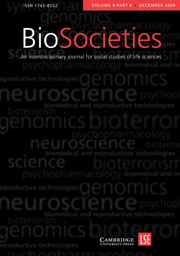Crossref Citations
This article has been cited by the following publications. This list is generated based on data provided by
Crossref.
Moreira, Tiago
and
Palladino, Paolo
2011.
‘Population laboratories’ or ‘laboratory populations’? Making sense of the Baltimore Longitudinal Study of Aging, 1965–1987.
Studies in History and Philosophy of Science Part C: Studies in History and Philosophy of Biological and Biomedical Sciences,
Vol. 42,
Issue. 3,
p.
317.
Latimer, Joanna
Davis, Terence
Bagley, Mark
and
Kipling, David
2011.
Ageing science, health care and social inclusion of older people.
Quality in Ageing and Older Adults,
Vol. 12,
Issue. 1,
p.
11.
Moser, Ingunn
2011.
Dementia and the Limits to Life: Anthropological Sensibilities, STS Interferences, and Possibilities for Action in Care.
Science, Technology, & Human Values,
Vol. 36,
Issue. 5,
p.
704.
Palladino, Paolo
2011.
Miranda’s story: molecules, populations and the mortal organism.
History of the Human Sciences,
Vol. 24,
Issue. 5,
p.
1.
Marshall, Barbara
and
Katz, Stephen
2012.
The Embodied Life Course: Post-ageism or the Renaturalization of Gender?.
Societies,
Vol. 2,
Issue. 4,
p.
222.
Park, Hyung Wook
2013.
Senescence, Growth, and Gerontology in the United States.
Journal of the History of Biology,
Vol. 46,
Issue. 4,
p.
631.
Lassen, Aske Juul
and
Moreira, Tiago
2014.
Unmaking old age: Political and cognitive formats of active ageing.
Journal of Aging Studies,
Vol. 30,
Issue. ,
p.
33.
Bülow, Morten Hillgaard
and
Söderqvist, Thomas
2014.
Successful ageing: A historical overview and critical analysis of a successful concept.
Journal of Aging Studies,
Vol. 31,
Issue. ,
p.
139.
Katz, Stephen
and
Gish, Jessica
2015.
Aging in the Biosocial Order: Repairing Time and Cosmetic Rejuvenation in a Medical Spa Clinic.
The Sociological Quarterly,
Vol. 56,
Issue. 1,
p.
40.
Moreira, Tiago
2015.
Unsettling Standards: The Biological Age Controversy.
The Sociological Quarterly,
Vol. 56,
Issue. 1,
p.
18.
Lafontaine, Céline
2015.
Aging in the Era of Regenerative Medicine: Analysis of Aging-Related Representations among Canadian Researchers.
The Sociological Quarterly,
Vol. 56,
Issue. 1,
p.
62.
Milne, Richard
2016.
In search of lost time: age and the promise of induced pluripotent stem cell models of the brain.
New Genetics and Society,
Vol. 35,
Issue. 4,
p.
393.
Burke, Lucy
2017.
Imagining a future without dementia: fictions of regeneration and the crises of work and sustainability.
Palgrave Communications,
Vol. 3,
Issue. 1,
Bolman, Brad
2018.
How experiments age: Gerontology, beagles, and species projection at Davis.
Social Studies of Science,
Vol. 48,
Issue. 2,
p.
232.
Müller, Ruth
and
Samaras, Georgia
2018.
Epigenetics and aging research: Between adult malleability and early life programming.
BioSocieties,
Vol. 13,
Issue. 4,
p.
715.
Latimer, Joanna
2019.
Science under siege? Being alongside the life sciences, giving science life.
The Sociological Review,
Vol. 67,
Issue. 2,
p.
264.
Van den Bogaert, Sarah
Ceuterick, Melissa
and
Bracke, Piet
2020.
The silver lining of greying: Ageing discourses and positioning of ageing persons in the field of social health insurance.
Health: An Interdisciplinary Journal for the Social Study of Health, Illness and Medicine,
Vol. 24,
Issue. 2,
p.
169.
Chen, Ningning
Chen, Jingfu
and
Ko, Pei‐Chun
2021.
Active aging in the countryside: Space, place and the performance of leisure–work lifestyles in contemporary rural China.
Population, Space and Place,
Vol. 27,
Issue. 6,
Cozza, Michela
Ellison, Kirsten L.
and
Katz, Stephen
2022.
Hacking age.
Sociology Compass,
Vol. 16,
Issue. 10,
Pinel, Clémence
Green, Sara
and
Svendsen, Mette N.
2023.
Slowing down decay: biological clocks in personalized medicine.
Frontiers in Sociology,
Vol. 8,
Issue. ,

